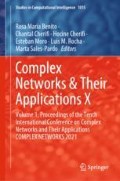Abstract
To characterize the “average” of a set of graphs, one can compute the sample Fréchet mean. We prove the following result: if we use the Hamming distance to compute distances between graphs, then the Fréchet mean of an ensemble of inhomogeneous random graphs is obtained by thresholding the expected adjacency matrix: an edge exists between the vertices i and j in the Fréchet mean graph if and only if the corresponding entry of the expected adjacency matrix is greater than 1/2. We prove that the result also holds for the sample Fréchet mean when the expected adjacency matrix is replaced with the sample mean adjacency matrix. This novel theoretical result has some significant practical consequences; for instance, the Fréchet mean of an ensemble of sparse inhomogeneous random graphs is the empty graph.
Access this chapter
Tax calculation will be finalised at checkout
Purchases are for personal use only
References
Banks, D., Constantine, G.: Metric models for random graphs. J. Classif. 15(2), 199–223 (1998)
Bollobás, B., Janson, S., Riordan, O.: The phase transition in inhomogeneous random graphs. Random Struct. Algorithms 31(1), 3–122 (2007)
Chen, J., Hermelin, D., Sorge, M.: On computing centroids according to the p-norms of Hamming distance vectors. In: 27th Annual European Symposium on Algorithms (ESA 2019), vol. 144, pp. 28:1–28:16, Dagstuhl, Germany (2019)
Chowdhury, S., Mémoli, F.: The metric space of networks (2018)
Dubey, P., Müller, H.G.: Fréchet change-point detection. Ann. Stat. 48(6), 3312–3335 (2020)
Ferrer, M., Valveny, E., Serratosa, F., Riesen, K., Bunke, H.: Generalized median graph computation by means of graph embedding in vector spaces. Pattern Recogn. 43(4), 1642–1655 (2010)
Fréchet, M.: Les espaces abstraits et leur utilité en statistique théorique et même en statistique appliquée. Journal de la Société Française de Statistique 88, 410–421 (1947)
Ginestet, C.E., Li, J., Balachandran, P., Rosenberg, S., Kolaczyk, E.D.: Hypothesis testing for network data in functional neuroimaging. Ann. Appl. Stat. 11(2), 725–750 (2017)
Han, F., Han, X., Liu, H., Caffo, B., et al.: Sparse median graphs estimation in a high-dimensional semiparametric model. Ann. Appl. Stat. 10(3), 1397–1426 (2016)
Jain, B.J.: Statistical graph space analysis. Pattern Recogn. 60, 802–812 (2016)
Jiang, X., Munger, A., Bunke, H.: On median graphs: properties, algorithms, and applications. IEEE Trans. Pattern Anal. Mach. Intell. 23(10), 1144–1151 (2001)
Josephs, N., Li, W., Kolaczyk, E.D.: Network recovery from unlabeled noisy samples (2021)
Kolaczyk, E.D., Lin, L., Rosenberg, S., Walters, J., Xu, J., et al.: Averages of unlabeled networks: geometric characterization and asymptotic behavior. Ann. Stat. 48(1), 514–538 (2020)
Lunagómez, S., Olhede, S.C., Wolfe, P.J.: Modeling network populations via graph distances. J. Am. Stat. Assoc. 1–18 (2020). Published online: 08 Sep 2020. https://www.tandfonline.com/doi/full/10.1080/01621459.2020.1763803
Meyer, F.G.: The Mean of Inhomogeneous Random Graphs (2021). https://github.com/francoismeyer/frechet-mean
Mukherjee, L., Singh, V., Peng, J., Xu, J., Zeitz, M.J., Berezney, R.: Generalized median graphs and applications. J. Comb. Optim. 17(1), 21–44 (2009)
Zambon, D., Alippi, C., Livi, L.: Change-point methods on a sequence of graphs. IEEE Trans. Signal Process. 67(24), 6327–6341 (2019)
Author information
Authors and Affiliations
Corresponding author
Editor information
Editors and Affiliations
Rights and permissions
Copyright information
© 2022 The Author(s), under exclusive license to Springer Nature Switzerland AG
About this paper
Cite this paper
Meyer, F.G. (2022). The Fréchet Mean of Inhomogeneous Random Graphs. In: Benito, R.M., Cherifi, C., Cherifi, H., Moro, E., Rocha, L.M., Sales-Pardo, M. (eds) Complex Networks & Their Applications X. COMPLEX NETWORKS 2021. Studies in Computational Intelligence, vol 1072. Springer, Cham. https://doi.org/10.1007/978-3-030-93409-5_18
Download citation
DOI: https://doi.org/10.1007/978-3-030-93409-5_18
Published:
Publisher Name: Springer, Cham
Print ISBN: 978-3-030-93408-8
Online ISBN: 978-3-030-93409-5
eBook Packages: EngineeringEngineering (R0)

